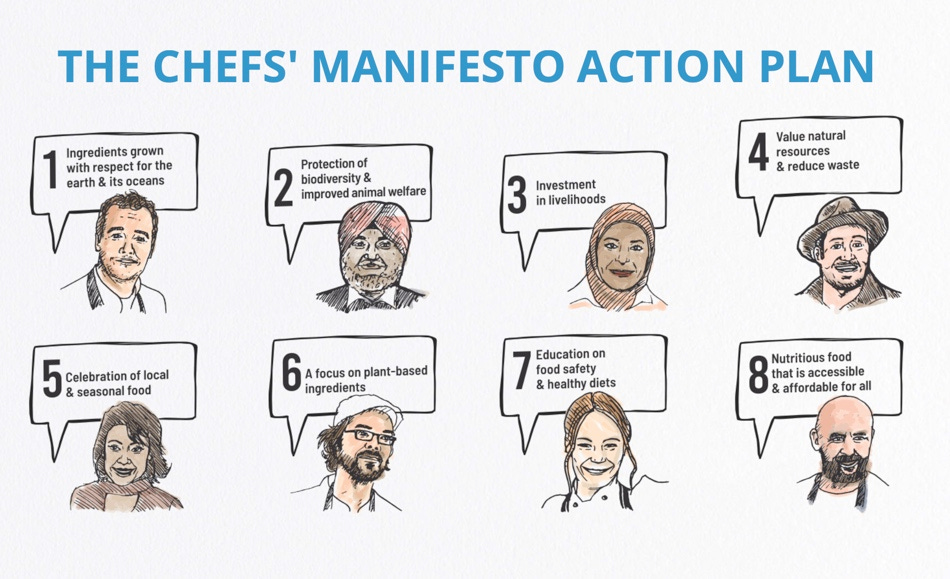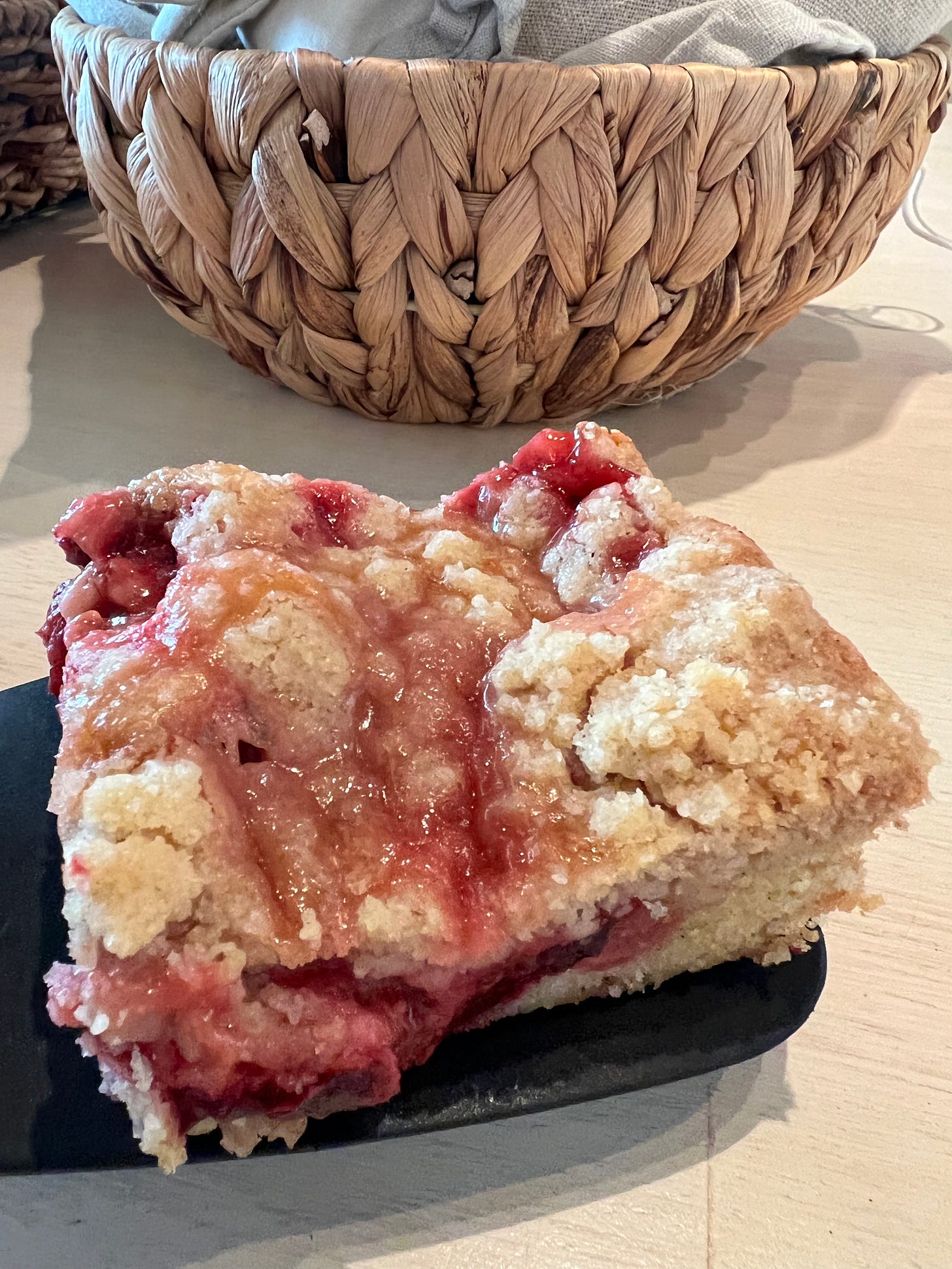We’ve reached a time when for me it seems impossible to think about our food choices and cooking methods without acknowledging their environmental impact. Much research shows that the way we grow, cook, consume, and dispose of our food is one of the largest contributors to climate change. I just read a review of glass and plastic containers that didn’t even mention the subject of sustainability, let alone evaluate which was better for the environment. Puzzling.
Last week’s edition of my What’s Burning podcast featured Paul Newnham, founder and director of the SDG2 Advocacy Hub and their Chefs’ Manifesto campaign (see above). Paul has created a global network of chefs working in their local communities and at the highest levels of global policy making to help achieve the U.N.’s Sustainable Development Goals (SDGs) by supporting and advocating for food-system change. He’s got a unique global perspective on the power of chefs and the role they can play in moving the needle toward a better future. Have a listen.
I had intended to write about an entirely different, cheesier subject this week when I saw someone on social media mention that there were still Italian plums in the farmers market. I rushed out to get some, quickly made this plum crumb cake from my Mensch Chef cookbook, and thought, I needed to share this recipe with you ASAP, while you still might be able to find some Italian plums yourself. Fromage fort can wait! (It gets better with age, anyway.)

There is a little backstory here. I used to make this cake at least once a year, when Italian plums (aka prune plums) first appeared in the market, sometime in late August or early September. I love plums in all forms (fresh, in jam, as prunes, baked in cakes). I love this kind of coffee cake, too, which I think of as being so Jewish, but which my German friend Marcus thinks of as being so German (probably not unrelated). Jewish or German, it’s the Italian plums that really make this cake sing, imho. They were one of my mother’s favorite fruits. When I see them, I always think of her.
Still, for some reason, the last couple of years I fell out of the habit of baking this cake. Instead, I got swept up in the ever-popular and super-easy plum torte from the New York Times, which is rightfully one of the most popular recipes the paper has ever published. It is delicious, but it is not a crumb cake, not this crumb cake.
This crumb cake recipe is also relatively simple. It is my riff on a cake originally created by the great pastry chef and culinary instructor Nick Malgieri, whose recipes for most classic baked goods have a way of reproducing the exact thing I have in mind, as though we grew up going to the same bakeries. Buy his books.
Some Notes
Plums are my preference for this crumb cake, but you can use apricots, cherries, blueberries, and other fruit, in season. Sometimes I reinforce the flavor of the filling with dabs of jam made from the same fruit. But when Italian plums are at or just past their peak—meaning they are overripe and a little more gooey than usual—there is no need for enhancement. Depending on how juicy the fruit is, the cake may need to bake longer than stated. Go by your eyes, not the recipe. There’s a moment when the cake (and most cakes) actually smells done. Follow your nose. It important that the fruit dries out some or you’ll have a dreaded “soggy top” that is unappealing and that severely diminishes how long the cake will keep. (You can still eat the edges.)
I usually add lemon zest to the recipe and bake it in a round, 10-inch springform pan. But for this most recent bake I didn’t seem to have a lemon anywhere in the fridge (unusual) and for some reason I wanted a rectangular crumb sheet cake, like the ones I remember on the back counter at the Steeles Bakery in the Jewish neighborhood of north Toronto, where I grew up. They were sold by the pound, which I think is something we should bring back. To add a little nutrition and complexity to the flavor and texture of the cake, I subbed rye flour for some of the all-purpose, too. The plums were very ripe and juicy, and because of the rectangular shape of the cake, it baked for more than an hour and fifteen minutes. I turned down the oven at the 50-minute mark so the edges wouldn’t over bake. It worked out great. A friend described it as “perfect.”
One Last Note about Making Crumbs
To make crumb topping, aka streusel, you can either melt and cool the butter, if you are taking it straight out of the fridge or freezer, or, if it’s at room temperature and really melty, you can just use it as is. Both work fine. The point is to moisten the dry ingredients just until they clump into crumbs, for which either the back of a fork or your fingertips work best.
RECIPE: Mitchell’s Plum Crumb Cake
(Makes 8 to 12 servings)
For the crumb topping
1 cup unbleached all-purpose flour
¼ cup rye flour, or additional all-purpose flour
½ cup sugar
¼ teaspoon ground cinnamon
Pinch salt
½ cup (4 ounces) unsalted butter, melted and cooled, or really softened at room temperature
For the cake
½ cup (4 ounces) unsalted butter, at room temperature
¾ cup sugar
2 large eggs
Zest of ½ lemon (optional)
1 teaspoon pure vanilla extract
1 cup unbleached all-purpose flour
¼ cup rye flour, or additional all-purpose flour
1 teaspoon baking powder
About 2 pounds (10 to 12) Italian prune plums, halved and pitted, or ripe apricots, halved and pitted, or 1 quart sour cherries, pitted, or other seasonal fruit
Preheat the oven to 350°F. Line a 10-inch round spring form pan or ¼ sheet pan (9 ½” by 13”) with parchment that overhangs on at least two sides, and grease with pan spray. Set aside.
To prepare the topping, in a medium bowl, combine the flour(s), sugar, cinnamon, and salt, and mix well. Add the butter and, using the back of a fork, work the butter in to moisten all the ingredients, making clumps. Your fingertips come in handy. Set aside.
For the cake, in a large bowl, cream the butter and sugar. Beat in the eggs, one at a time, until incorporated, and then continue beating until light and creamy. Beat in the lemon zest, if using, and vanilla. Add the flour(s) and baking powder and stir just until incorporated. Don’t overmix.
Transfer the cake batter to the prepared pan and using a small, off-set spatual, spread evenly to the edges of the pan. Arrange the plum halves or other fruit on top of the batter, cut side up. Using your fingertips to both clump and break up the crumb mixture, distribute the topping evenly over the top of the fruit. It’s okay if some plums peak out.
Set in the preheated oven and bake for 50 to 60 minutes, or more, until the top is somewhat browned, the fruit is bubbly, and center has set. An instant-read thermometer inserted in the center should hit at least 195°F. If it looks loose, wet, or wobbly, continue baking in five-minute increments until baked through. You may want to lower the oven to 325°F. to prevent the edges from overbaking.
Remove from the oven and let cool completely in the pan on a rack. To unmold, run a knife around the edges and use the parchment to remove the cake to a serving plate before slicing. The cake will keep in best form at room temperature for up to two days, but should be refrigerated after that.
Still Feeling Crumby
Because the season for plums really is at its end, I’ve also been experimenting with pumpkin crumb cakes lately. Winter squash season is just beginning. For the time being, I’ve settled on this one, which is sort of like a cross between a pumpkin pie and a streusel coffee cake.
Nate was shocked to learn that most pumpkin baked goods made from scratch use butternut or similar squash rather than pumpkin. They are easier to handle and have a better flavor and texture. (I haven’t broached the harsh reality that, as the pumpkin spice craze indicates, nobody even cares if there is any pumpkin or squash in pumpkin things; they just want the flavor of the spices associated with it.) In an earlier edition of my newsletter (see Issue #19), I described how to make squash purée simply by roasting cut halves. For this recipe, one smallish Honeypatch squash (those new, cute squash developed by Row Seven Seeds) yields about exactly as much as you need.
The high ratio of crumb to cake, about 50-50, makes for a rugged topography that provides textural contrast and great flavor. Neither is too sweet, which I like, too. The original recipe appeared in Bon Appétit, but I subbed out half the all-purpose flour in the crumb for rye flour, as I’m wont to do, clearly, and upped the squash in the cake to make it even more like pie filling. We all agreed, it’s delicious.
RECIPE: Pumpkin Rye Crumb Cake
(Serves 8 to 10)
For the crumb topping
3/4 cup (6 ounces) unsalted butter, melted and cooled, or really softened at room temperature
1 cup all-purpose flour
1 cup rye flour, or additional all-purpose flour
2/3 cup packed light brown sugar
1 ½ teaspoons ground cinnamon
1 teaspoon kosher salt
½ teaspoon freshly grated nutmeg
¼ teaspoon ground cloves
For the cake
1 cup all-purpose flour
1 teaspoon kosher salt
1 teaspoon baking powder
¼ teaspoon baking soda
½ teaspoon ground cinnamon
2 large eggs
½ cup granulated sugar
¼ cup packed light brown sugar
1 cup roasted squash or pumpkin purée
½ cup vegetable oil
1 tablespoon finely grated fresh ginger or ¼ teaspoon ground ginger
1 teaspoon pure vanilla extract
Powdered sugar, for dusting
Preheat the oven to 350°F. Line an 8-inch square cake pan, 7-inch-by-10-inch baking dish, or other pan with similar surface area with parchment that overhangs on at least two sides, and grease with pan spray.
For the toping combine the flour(s) with the brown sugar, cinnamon, salt, nutmeg, and cloves. Whisk together to blend well. Add the butter and, stirring with the back of a fork, moisten the dry ingredients until they form clumps and coarse crumbs. Get your fingertips in there to help.
For the cake, in a large bowl, combine the flour, salt, baking powder, baking soda, and cinnamon. In a medium bowl, beat together the eggs, sugars, pumpkin purée, and oil until smooth. Beat in the ginger and vanilla. Add this pumpkin mixture to the dry ingredients and, using a wooden spoon or rubber spatula, gently stir until just combined. Don’t overmix. Scrape the batter into the prepared pan and, using a small off-set spatula, spread in an even layer all the way to edges.
Using your fingers to both clump and break up the crumb mixture, distribute the topping evenly over the top of the cake. There is a lot of it, but just pile it on. Don’t press it down. Bake until set, 40 to 45 minutes, or until an instant-read thermometer reaches at least 195°F. and comes out clean. Transfer the pan to a wire rack and let cool about an hour. Run a knife around the edges and, using the parchment overhang, lift the cake out of pan and onto the rack to cool completely. Dust with powdered sugar before cutting into pieces to serve. The cake will keep in its best form for up to three days at room temperature and then should be refrigerated.










German. Definitely German.